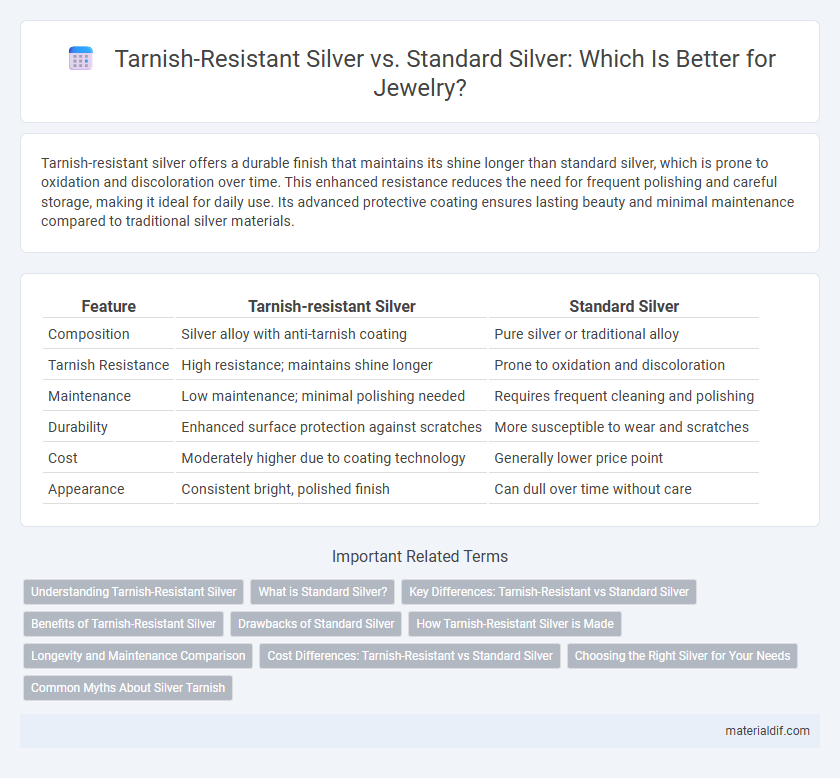Tarnish-resistant silver offers a durable finish that maintains its shine longer than standard silver, which is prone to oxidation and discoloration over time. This enhanced resistance reduces the need for frequent polishing and careful storage, making it ideal for daily use. Its advanced protective coating ensures lasting beauty and minimal maintenance compared to traditional silver materials.
Table of Comparison
| Feature | Tarnish-resistant Silver | Standard Silver |
|---|---|---|
| Composition | Silver alloy with anti-tarnish coating | Pure silver or traditional alloy |
| Tarnish Resistance | High resistance; maintains shine longer | Prone to oxidation and discoloration |
| Maintenance | Low maintenance; minimal polishing needed | Requires frequent cleaning and polishing |
| Durability | Enhanced surface protection against scratches | More susceptible to wear and scratches |
| Cost | Moderately higher due to coating technology | Generally lower price point |
| Appearance | Consistent bright, polished finish | Can dull over time without care |
Understanding Tarnish-Resistant Silver
Tarnish-resistant silver contains a protective layer, often made from rhodium or other anti-tarnish coatings, that inhibits the chemical reaction between silver and sulfur compounds in the air, which causes tarnishing. Standard silver, typically 92.5% pure sterling silver, naturally oxidizes over time and requires regular polishing to maintain its shine. Choosing tarnish-resistant silver reduces maintenance efforts while preserving the metal's luster and extending its aesthetic lifespan.
What is Standard Silver?
Standard silver, often referred to as sterling silver, consists of 92.5% pure silver alloyed with 7.5% other metals, typically copper, to enhance its strength and durability. This composition makes standard silver prone to tarnish over time due to its reaction with sulfur compounds in the air, forming a darkened surface layer. Tarnish-resistant silver incorporates additional elements or protective coatings designed to prevent or slow down this oxidation process, maintaining its shine longer than standard silver.
Key Differences: Tarnish-Resistant vs Standard Silver
Tarnish-resistant silver contains a protective layer that prevents oxidation, maintaining its shine longer than standard silver, which naturally reacts with sulfur and moisture to form tarnish. Standard silver requires regular polishing to remove the dull, darkened surface, whereas tarnish-resistant silver minimizes maintenance due to its anti-tarnish coating or alloy composition. The key difference lies in durability and upkeep, with tarnish-resistant silver offering enhanced longevity and appearance compared to the more reactive and maintenance-intensive standard silver.
Benefits of Tarnish-Resistant Silver
Tarnish-resistant silver offers enhanced durability by maintaining its shine and luster longer than standard silver, reducing the need for frequent polishing. This type of silver resists oxidation and discoloration, ensuring jewelry and tableware retain their aesthetic appeal over time. Its low-maintenance properties make it ideal for everyday use, providing lasting value and convenience.
Drawbacks of Standard Silver
Standard silver tarnishes quickly when exposed to sulfur-containing compounds and moisture, leading to unsightly darkening that requires frequent polishing. This chemical reaction not only diminishes its aesthetic appeal but also accelerates surface degradation over time. The maintenance demands and vulnerability to tarnish make standard silver less practical for everyday use compared to tarnish-resistant silver alloys.
How Tarnish-Resistant Silver is Made
Tarnish-resistant silver is created by alloying pure silver with elements such as copper, zinc, or germanium, which inhibit oxidation and discoloration. Advanced manufacturing techniques include applying protective coatings or surface treatments like rhodium plating to enhance durability and maintain the silver's luster. This combination of alloy composition and surface technology significantly reduces tarnishing compared to standard silver, which is more prone to react with sulfur compounds in the environment.
Longevity and Maintenance Comparison
Tarnish-resistant silver features a protective coating that significantly extends its longevity by preventing oxidation and discoloration, reducing the need for frequent polishing compared to standard silver. Standard silver, composed primarily of sterling silver, requires regular maintenance to remove tarnish caused by exposure to air and moisture, which can degrade its appearance over time. Choosing tarnish-resistant silver enhances durability and lowers upkeep efforts, making it ideal for users seeking long-term preservation and minimal maintenance.
Cost Differences: Tarnish-Resistant vs Standard Silver
Tarnish-resistant silver typically commands a higher price than standard silver due to the added alloys and treatments that enhance its durability and longevity. Standard silver, primarily composed of 92.5% pure silver or sterling silver, is more affordable but requires frequent maintenance to prevent oxidation and darkening. The upfront investment in tarnish-resistant silver often results in lower long-term care costs, making it a cost-effective option despite the initial premium.
Choosing the Right Silver for Your Needs
Tarnish-resistant silver offers enhanced durability and minimal maintenance, making it ideal for everyday jewelry and household items exposed to air and moisture. Standard silver, typically 92.5% pure sterling silver, may develop tarnish over time but provides a traditional look favored for collectible and fine jewelry pieces. Selecting the right silver depends on whether ease of care or authentic silver craftsmanship aligns best with your lifestyle and intended use.
Common Myths About Silver Tarnish
Tarnish-resistant silver alloys contain protective metals like palladium or rhodium, which minimize oxidation compared to standard silver composed primarily of 92.5% pure silver and 7.5% copper. A common myth claims that silver tarnishes solely because of exposure to air, but it is actually sulfur compounds in the environment that cause the chemical reaction leading to silver tarnish. Contrary to popular belief, tarnish does not indicate poor silver quality but is a natural process that can be slowed by using tarnish-resistant coatings or regular maintenance.
Tarnish-resistant Silver vs Standard Silver Infographic

 materialdif.com
materialdif.com